Level 4 Essay: Impacts of Tourism on Society: Theories and Practices
VerifiedAdded on 2023/06/05
|8
|2714
|422
Essay
AI Summary
This essay delves into the intricate relationship between tourism and society, examining the multifaceted impacts of tourism on various aspects of society. The introduction establishes the essay's purpose: to explore how tourism and society influence each other. The main body discusses the tourism industry, its growth, and its significance. It analyzes the push and pull model and Leiper's Tourism system model to measure the increase in demand for tourism and the role of stakeholders. The essay then uses PESTEL analysis to evaluate the macro factors influencing the tourism industry and discusses the positive and negative impacts of political, economic, social, technological, environmental, and legal factors. It further explores different types of tourism, including drifter, explorer, mass tourism, and organized mass tourism, and their effects on the industry. The essay concludes by summarizing the key findings, highlighting the growth of tourism and its impact on society's standards, while emphasizing the importance of sustainable environmental conditions.
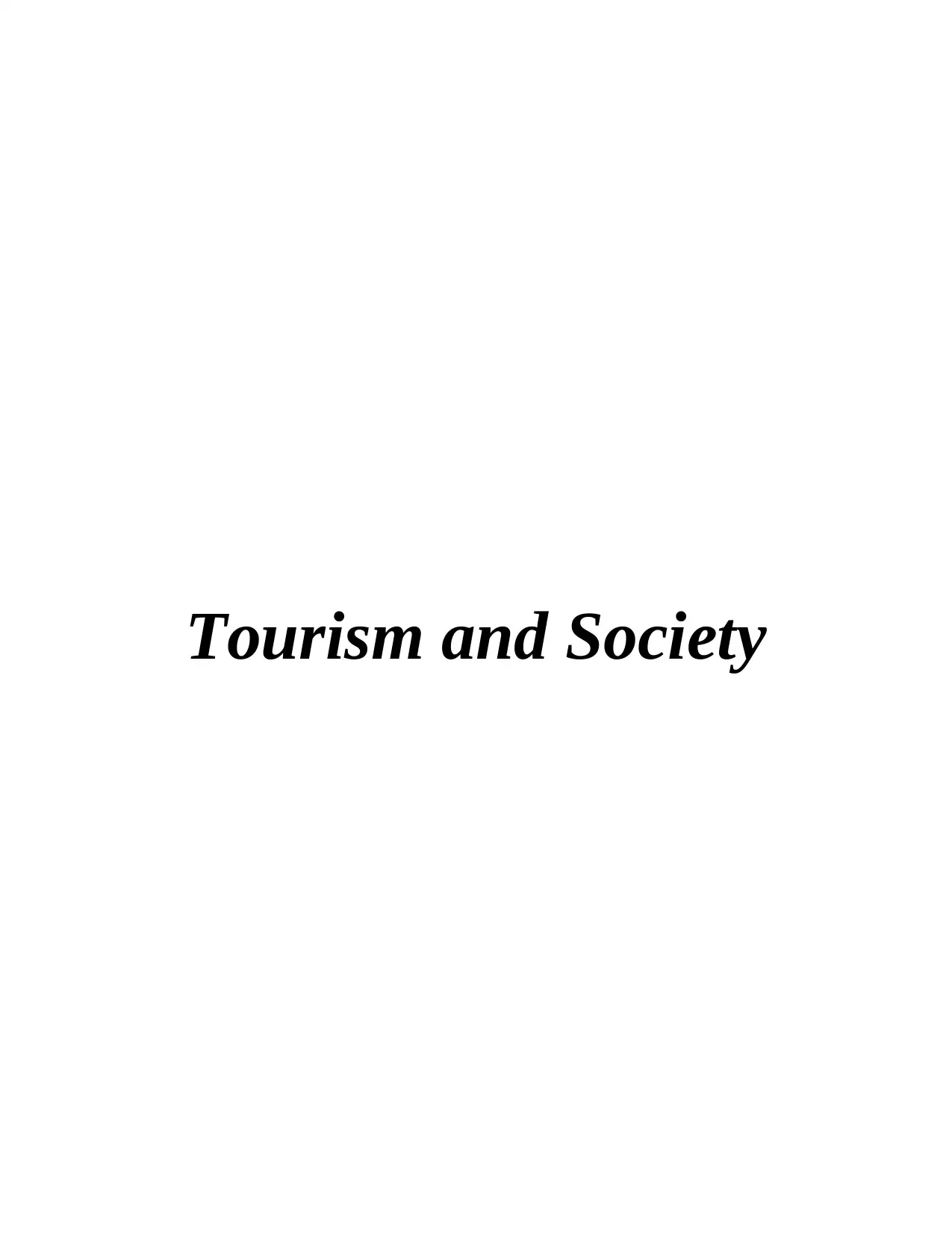
Tourism and Society
Paraphrase This Document
Need a fresh take? Get an instant paraphrase of this document with our AI Paraphraser
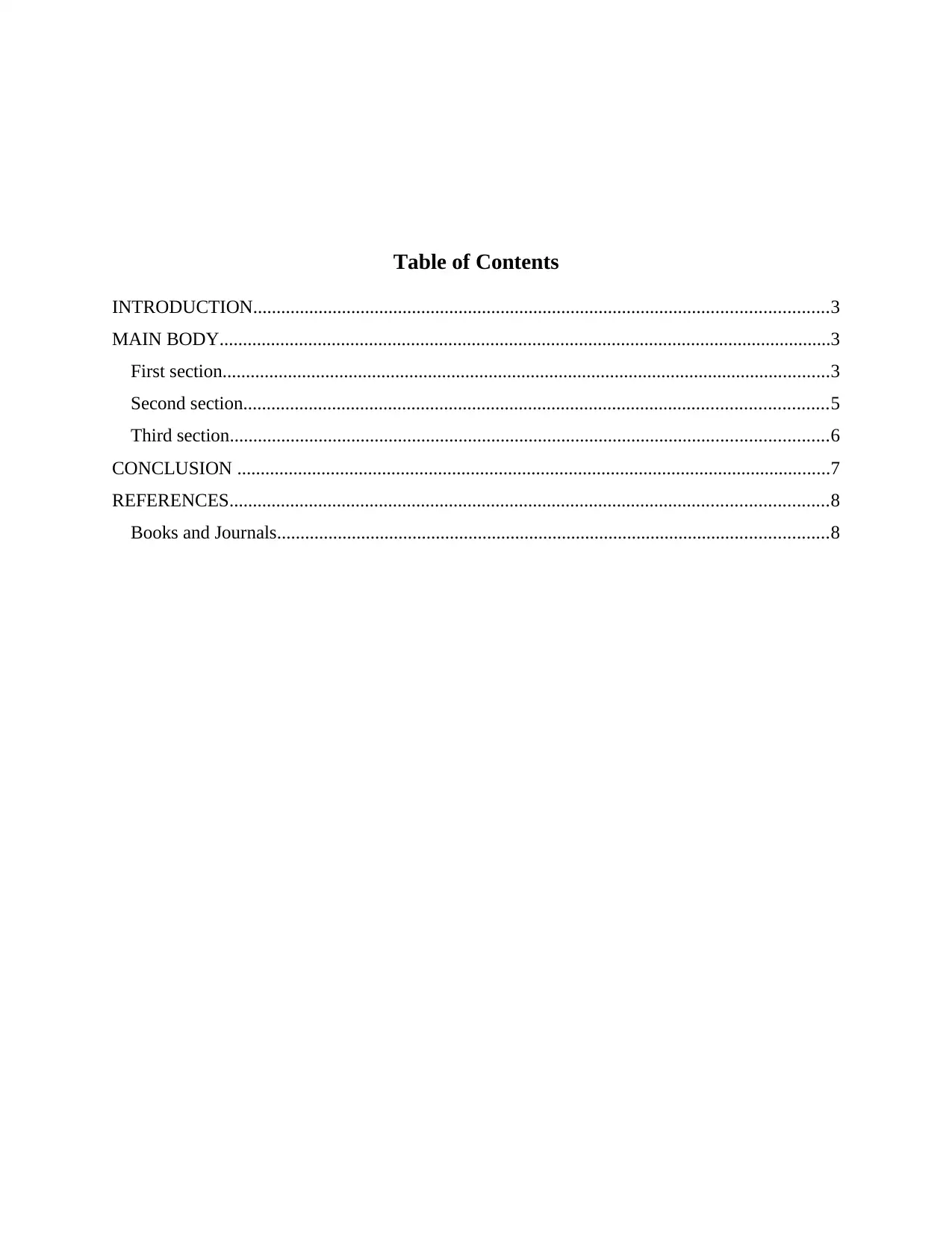
Table of Contents
INTRODUCTION...........................................................................................................................3
MAIN BODY...................................................................................................................................3
First section..................................................................................................................................3
Second section.............................................................................................................................5
Third section................................................................................................................................6
CONCLUSION ...............................................................................................................................7
REFERENCES................................................................................................................................8
Books and Journals......................................................................................................................8
INTRODUCTION...........................................................................................................................3
MAIN BODY...................................................................................................................................3
First section..................................................................................................................................3
Second section.............................................................................................................................5
Third section................................................................................................................................6
CONCLUSION ...............................................................................................................................7
REFERENCES................................................................................................................................8
Books and Journals......................................................................................................................8
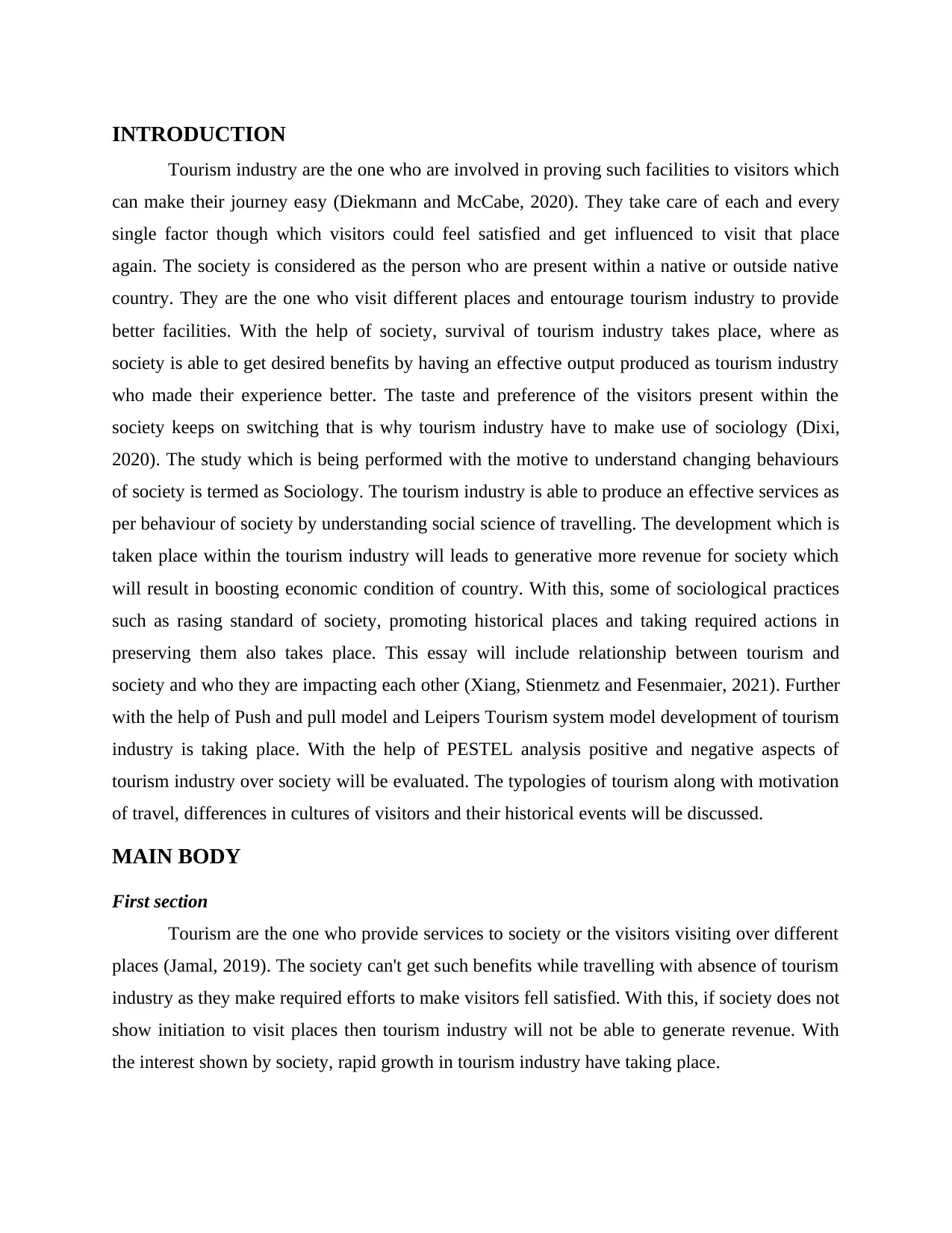
INTRODUCTION
Tourism industry are the one who are involved in proving such facilities to visitors which
can make their journey easy (Diekmann and McCabe, 2020). They take care of each and every
single factor though which visitors could feel satisfied and get influenced to visit that place
again. The society is considered as the person who are present within a native or outside native
country. They are the one who visit different places and entourage tourism industry to provide
better facilities. With the help of society, survival of tourism industry takes place, where as
society is able to get desired benefits by having an effective output produced as tourism industry
who made their experience better. The taste and preference of the visitors present within the
society keeps on switching that is why tourism industry have to make use of sociology (Dixi,
2020). The study which is being performed with the motive to understand changing behaviours
of society is termed as Sociology. The tourism industry is able to produce an effective services as
per behaviour of society by understanding social science of travelling. The development which is
taken place within the tourism industry will leads to generative more revenue for society which
will result in boosting economic condition of country. With this, some of sociological practices
such as rasing standard of society, promoting historical places and taking required actions in
preserving them also takes place. This essay will include relationship between tourism and
society and who they are impacting each other (Xiang, Stienmetz and Fesenmaier, 2021). Further
with the help of Push and pull model and Leipers Tourism system model development of tourism
industry is taking place. With the help of PESTEL analysis positive and negative aspects of
tourism industry over society will be evaluated. The typologies of tourism along with motivation
of travel, differences in cultures of visitors and their historical events will be discussed.
MAIN BODY
First section
Tourism are the one who provide services to society or the visitors visiting over different
places (Jamal, 2019). The society can't get such benefits while travelling with absence of tourism
industry as they make required efforts to make visitors fell satisfied. With this, if society does not
show initiation to visit places then tourism industry will not be able to generate revenue. With
the interest shown by society, rapid growth in tourism industry have taking place.
Tourism industry are the one who are involved in proving such facilities to visitors which
can make their journey easy (Diekmann and McCabe, 2020). They take care of each and every
single factor though which visitors could feel satisfied and get influenced to visit that place
again. The society is considered as the person who are present within a native or outside native
country. They are the one who visit different places and entourage tourism industry to provide
better facilities. With the help of society, survival of tourism industry takes place, where as
society is able to get desired benefits by having an effective output produced as tourism industry
who made their experience better. The taste and preference of the visitors present within the
society keeps on switching that is why tourism industry have to make use of sociology (Dixi,
2020). The study which is being performed with the motive to understand changing behaviours
of society is termed as Sociology. The tourism industry is able to produce an effective services as
per behaviour of society by understanding social science of travelling. The development which is
taken place within the tourism industry will leads to generative more revenue for society which
will result in boosting economic condition of country. With this, some of sociological practices
such as rasing standard of society, promoting historical places and taking required actions in
preserving them also takes place. This essay will include relationship between tourism and
society and who they are impacting each other (Xiang, Stienmetz and Fesenmaier, 2021). Further
with the help of Push and pull model and Leipers Tourism system model development of tourism
industry is taking place. With the help of PESTEL analysis positive and negative aspects of
tourism industry over society will be evaluated. The typologies of tourism along with motivation
of travel, differences in cultures of visitors and their historical events will be discussed.
MAIN BODY
First section
Tourism are the one who provide services to society or the visitors visiting over different
places (Jamal, 2019). The society can't get such benefits while travelling with absence of tourism
industry as they make required efforts to make visitors fell satisfied. With this, if society does not
show initiation to visit places then tourism industry will not be able to generate revenue. With
the interest shown by society, rapid growth in tourism industry have taking place.
⊘ This is a preview!⊘
Do you want full access?
Subscribe today to unlock all pages.

Trusted by 1+ million students worldwide
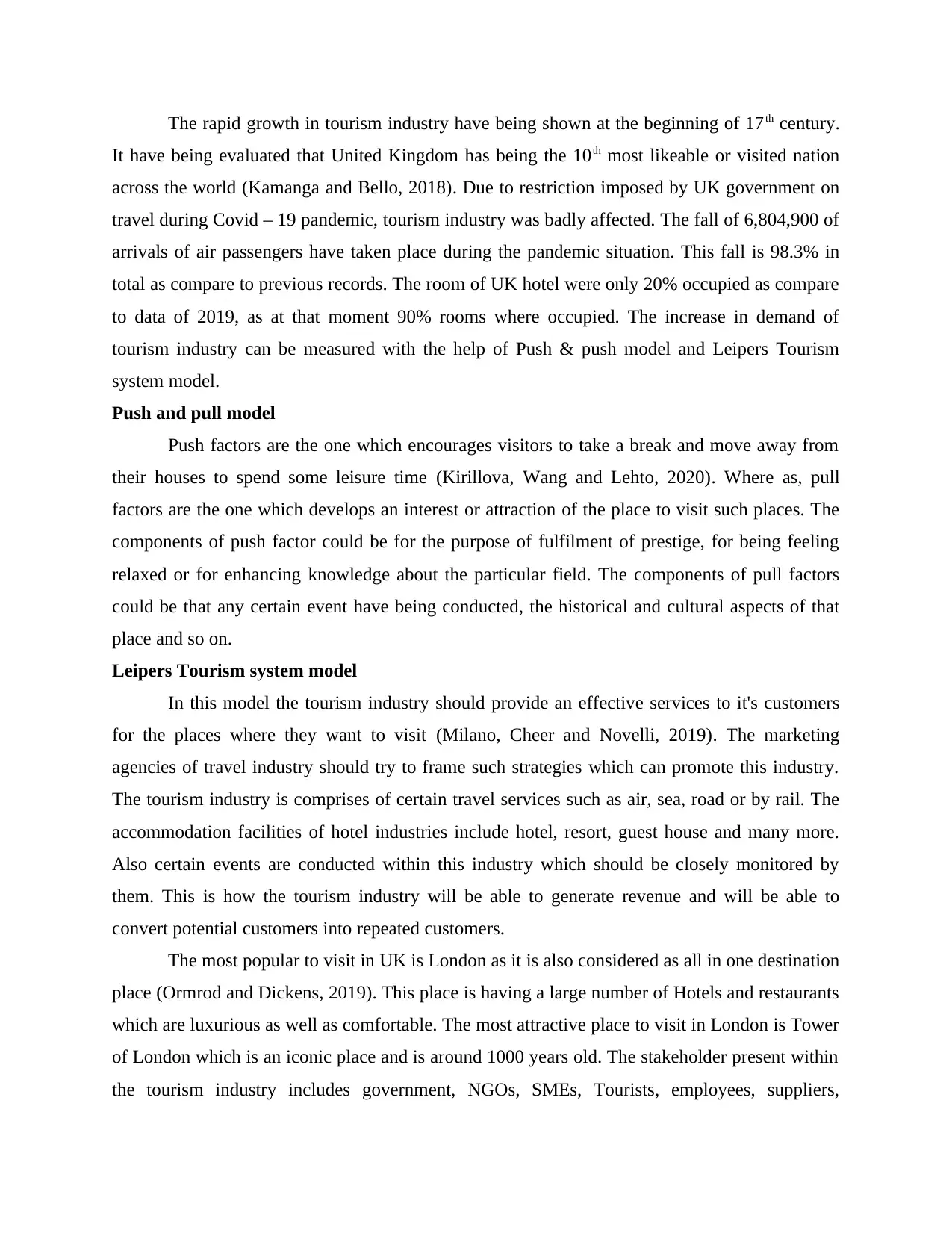
The rapid growth in tourism industry have being shown at the beginning of 17th century.
It have being evaluated that United Kingdom has being the 10th most likeable or visited nation
across the world (Kamanga and Bello, 2018). Due to restriction imposed by UK government on
travel during Covid – 19 pandemic, tourism industry was badly affected. The fall of 6,804,900 of
arrivals of air passengers have taken place during the pandemic situation. This fall is 98.3% in
total as compare to previous records. The room of UK hotel were only 20% occupied as compare
to data of 2019, as at that moment 90% rooms where occupied. The increase in demand of
tourism industry can be measured with the help of Push & push model and Leipers Tourism
system model.
Push and pull model
Push factors are the one which encourages visitors to take a break and move away from
their houses to spend some leisure time (Kirillova, Wang and Lehto, 2020). Where as, pull
factors are the one which develops an interest or attraction of the place to visit such places. The
components of push factor could be for the purpose of fulfilment of prestige, for being feeling
relaxed or for enhancing knowledge about the particular field. The components of pull factors
could be that any certain event have being conducted, the historical and cultural aspects of that
place and so on.
Leipers Tourism system model
In this model the tourism industry should provide an effective services to it's customers
for the places where they want to visit (Milano, Cheer and Novelli, 2019). The marketing
agencies of travel industry should try to frame such strategies which can promote this industry.
The tourism industry is comprises of certain travel services such as air, sea, road or by rail. The
accommodation facilities of hotel industries include hotel, resort, guest house and many more.
Also certain events are conducted within this industry which should be closely monitored by
them. This is how the tourism industry will be able to generate revenue and will be able to
convert potential customers into repeated customers.
The most popular to visit in UK is London as it is also considered as all in one destination
place (Ormrod and Dickens, 2019). This place is having a large number of Hotels and restaurants
which are luxurious as well as comfortable. The most attractive place to visit in London is Tower
of London which is an iconic place and is around 1000 years old. The stakeholder present within
the tourism industry includes government, NGOs, SMEs, Tourists, employees, suppliers,
It have being evaluated that United Kingdom has being the 10th most likeable or visited nation
across the world (Kamanga and Bello, 2018). Due to restriction imposed by UK government on
travel during Covid – 19 pandemic, tourism industry was badly affected. The fall of 6,804,900 of
arrivals of air passengers have taken place during the pandemic situation. This fall is 98.3% in
total as compare to previous records. The room of UK hotel were only 20% occupied as compare
to data of 2019, as at that moment 90% rooms where occupied. The increase in demand of
tourism industry can be measured with the help of Push & push model and Leipers Tourism
system model.
Push and pull model
Push factors are the one which encourages visitors to take a break and move away from
their houses to spend some leisure time (Kirillova, Wang and Lehto, 2020). Where as, pull
factors are the one which develops an interest or attraction of the place to visit such places. The
components of push factor could be for the purpose of fulfilment of prestige, for being feeling
relaxed or for enhancing knowledge about the particular field. The components of pull factors
could be that any certain event have being conducted, the historical and cultural aspects of that
place and so on.
Leipers Tourism system model
In this model the tourism industry should provide an effective services to it's customers
for the places where they want to visit (Milano, Cheer and Novelli, 2019). The marketing
agencies of travel industry should try to frame such strategies which can promote this industry.
The tourism industry is comprises of certain travel services such as air, sea, road or by rail. The
accommodation facilities of hotel industries include hotel, resort, guest house and many more.
Also certain events are conducted within this industry which should be closely monitored by
them. This is how the tourism industry will be able to generate revenue and will be able to
convert potential customers into repeated customers.
The most popular to visit in UK is London as it is also considered as all in one destination
place (Ormrod and Dickens, 2019). This place is having a large number of Hotels and restaurants
which are luxurious as well as comfortable. The most attractive place to visit in London is Tower
of London which is an iconic place and is around 1000 years old. The stakeholder present within
the tourism industry includes government, NGOs, SMEs, Tourists, employees, suppliers,
Paraphrase This Document
Need a fresh take? Get an instant paraphrase of this document with our AI Paraphraser
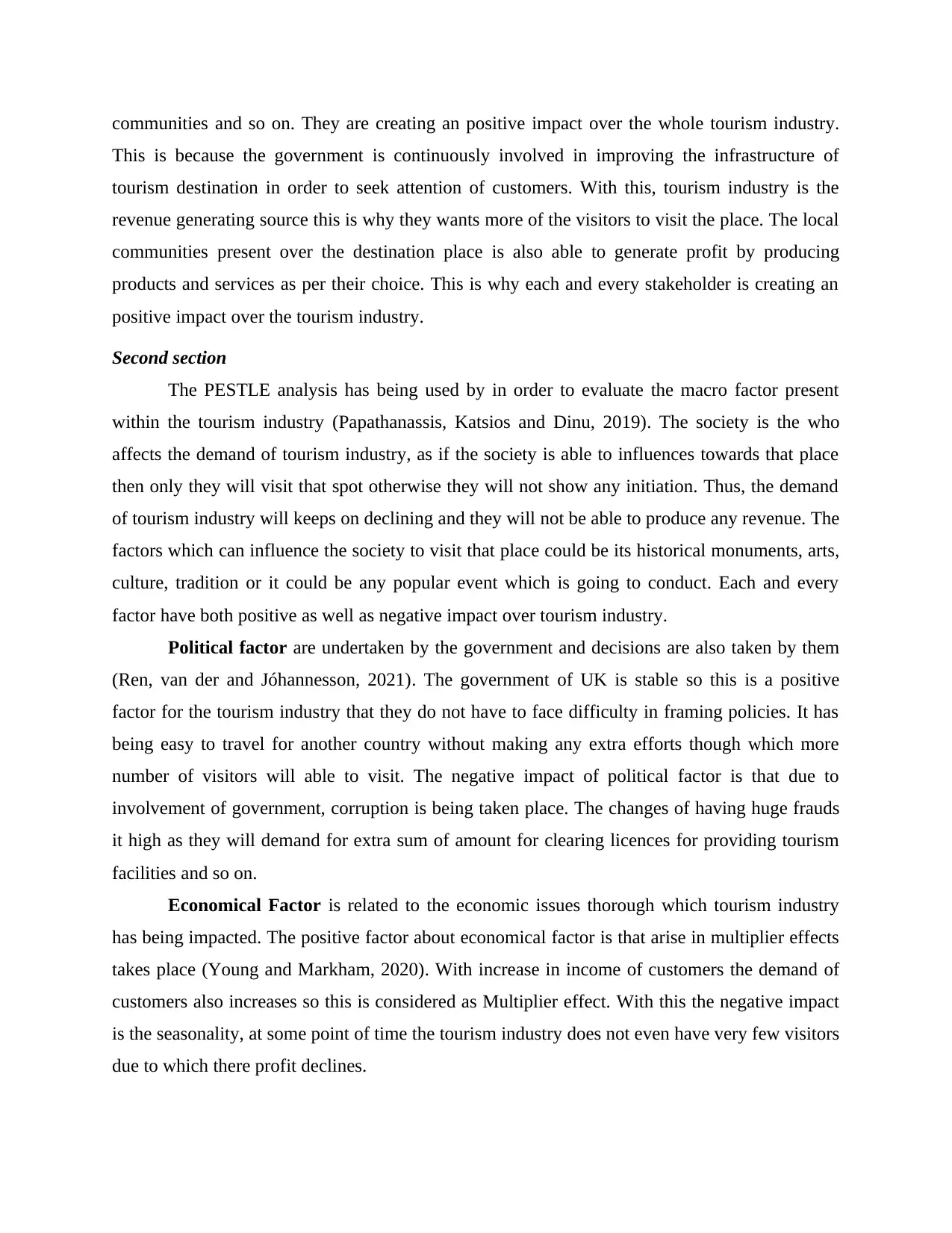
communities and so on. They are creating an positive impact over the whole tourism industry.
This is because the government is continuously involved in improving the infrastructure of
tourism destination in order to seek attention of customers. With this, tourism industry is the
revenue generating source this is why they wants more of the visitors to visit the place. The local
communities present over the destination place is also able to generate profit by producing
products and services as per their choice. This is why each and every stakeholder is creating an
positive impact over the tourism industry.
Second section
The PESTLE analysis has being used by in order to evaluate the macro factor present
within the tourism industry (Papathanassis, Katsios and Dinu, 2019). The society is the who
affects the demand of tourism industry, as if the society is able to influences towards that place
then only they will visit that spot otherwise they will not show any initiation. Thus, the demand
of tourism industry will keeps on declining and they will not be able to produce any revenue. The
factors which can influence the society to visit that place could be its historical monuments, arts,
culture, tradition or it could be any popular event which is going to conduct. Each and every
factor have both positive as well as negative impact over tourism industry.
Political factor are undertaken by the government and decisions are also taken by them
(Ren, van der and Jóhannesson, 2021). The government of UK is stable so this is a positive
factor for the tourism industry that they do not have to face difficulty in framing policies. It has
being easy to travel for another country without making any extra efforts though which more
number of visitors will able to visit. The negative impact of political factor is that due to
involvement of government, corruption is being taken place. The changes of having huge frauds
it high as they will demand for extra sum of amount for clearing licences for providing tourism
facilities and so on.
Economical Factor is related to the economic issues thorough which tourism industry
has being impacted. The positive factor about economical factor is that arise in multiplier effects
takes place (Young and Markham, 2020). With increase in income of customers the demand of
customers also increases so this is considered as Multiplier effect. With this the negative impact
is the seasonality, at some point of time the tourism industry does not even have very few visitors
due to which there profit declines.
This is because the government is continuously involved in improving the infrastructure of
tourism destination in order to seek attention of customers. With this, tourism industry is the
revenue generating source this is why they wants more of the visitors to visit the place. The local
communities present over the destination place is also able to generate profit by producing
products and services as per their choice. This is why each and every stakeholder is creating an
positive impact over the tourism industry.
Second section
The PESTLE analysis has being used by in order to evaluate the macro factor present
within the tourism industry (Papathanassis, Katsios and Dinu, 2019). The society is the who
affects the demand of tourism industry, as if the society is able to influences towards that place
then only they will visit that spot otherwise they will not show any initiation. Thus, the demand
of tourism industry will keeps on declining and they will not be able to produce any revenue. The
factors which can influence the society to visit that place could be its historical monuments, arts,
culture, tradition or it could be any popular event which is going to conduct. Each and every
factor have both positive as well as negative impact over tourism industry.
Political factor are undertaken by the government and decisions are also taken by them
(Ren, van der and Jóhannesson, 2021). The government of UK is stable so this is a positive
factor for the tourism industry that they do not have to face difficulty in framing policies. It has
being easy to travel for another country without making any extra efforts though which more
number of visitors will able to visit. The negative impact of political factor is that due to
involvement of government, corruption is being taken place. The changes of having huge frauds
it high as they will demand for extra sum of amount for clearing licences for providing tourism
facilities and so on.
Economical Factor is related to the economic issues thorough which tourism industry
has being impacted. The positive factor about economical factor is that arise in multiplier effects
takes place (Young and Markham, 2020). With increase in income of customers the demand of
customers also increases so this is considered as Multiplier effect. With this the negative impact
is the seasonality, at some point of time the tourism industry does not even have very few visitors
due to which there profit declines.
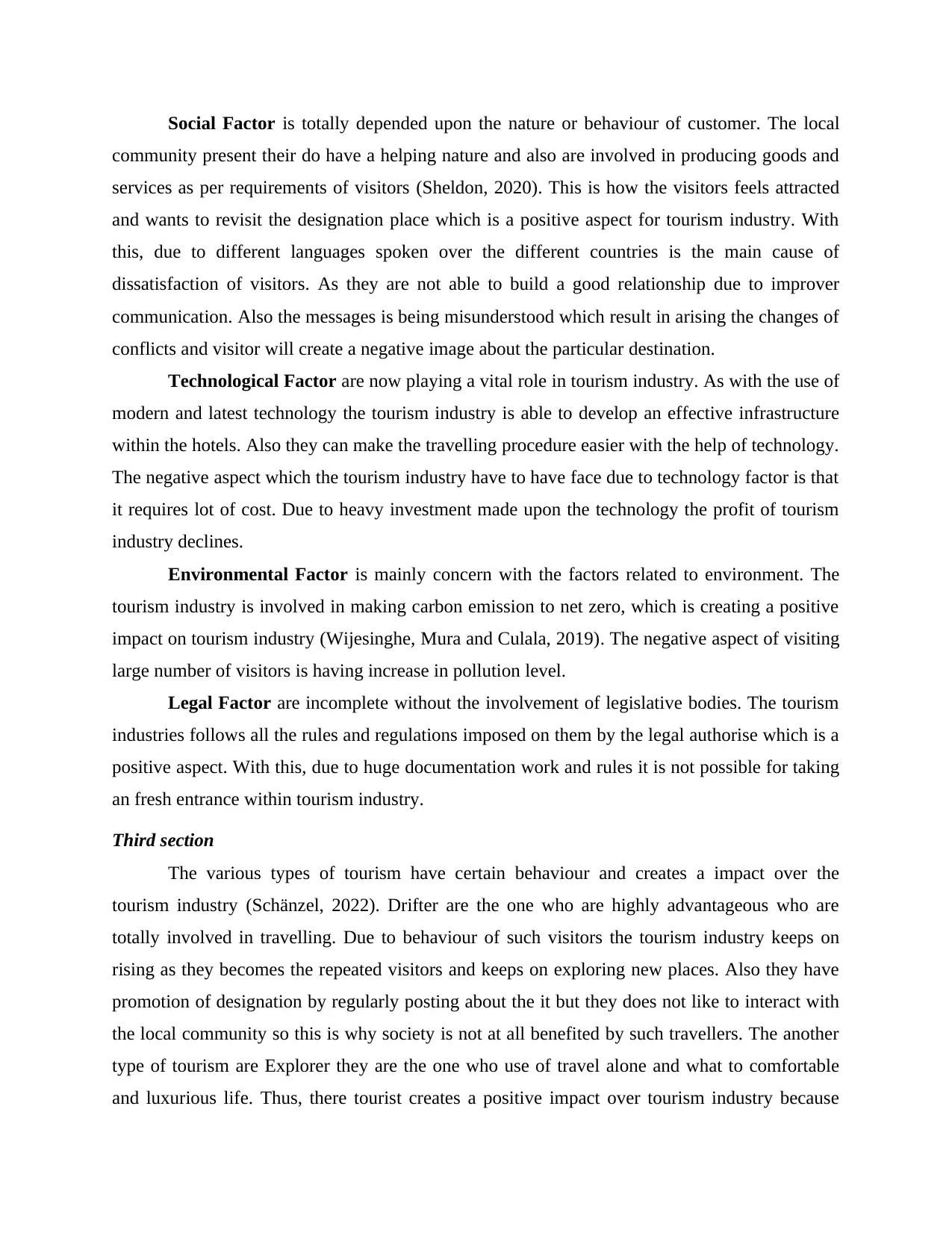
Social Factor is totally depended upon the nature or behaviour of customer. The local
community present their do have a helping nature and also are involved in producing goods and
services as per requirements of visitors (Sheldon, 2020). This is how the visitors feels attracted
and wants to revisit the designation place which is a positive aspect for tourism industry. With
this, due to different languages spoken over the different countries is the main cause of
dissatisfaction of visitors. As they are not able to build a good relationship due to improver
communication. Also the messages is being misunderstood which result in arising the changes of
conflicts and visitor will create a negative image about the particular destination.
Technological Factor are now playing a vital role in tourism industry. As with the use of
modern and latest technology the tourism industry is able to develop an effective infrastructure
within the hotels. Also they can make the travelling procedure easier with the help of technology.
The negative aspect which the tourism industry have to have face due to technology factor is that
it requires lot of cost. Due to heavy investment made upon the technology the profit of tourism
industry declines.
Environmental Factor is mainly concern with the factors related to environment. The
tourism industry is involved in making carbon emission to net zero, which is creating a positive
impact on tourism industry (Wijesinghe, Mura and Culala, 2019). The negative aspect of visiting
large number of visitors is having increase in pollution level.
Legal Factor are incomplete without the involvement of legislative bodies. The tourism
industries follows all the rules and regulations imposed on them by the legal authorise which is a
positive aspect. With this, due to huge documentation work and rules it is not possible for taking
an fresh entrance within tourism industry.
Third section
The various types of tourism have certain behaviour and creates a impact over the
tourism industry (Schänzel, 2022). Drifter are the one who are highly advantageous who are
totally involved in travelling. Due to behaviour of such visitors the tourism industry keeps on
rising as they becomes the repeated visitors and keeps on exploring new places. Also they have
promotion of designation by regularly posting about the it but they does not like to interact with
the local community so this is why society is not at all benefited by such travellers. The another
type of tourism are Explorer they are the one who use of travel alone and what to comfortable
and luxurious life. Thus, there tourist creates a positive impact over tourism industry because
community present their do have a helping nature and also are involved in producing goods and
services as per requirements of visitors (Sheldon, 2020). This is how the visitors feels attracted
and wants to revisit the designation place which is a positive aspect for tourism industry. With
this, due to different languages spoken over the different countries is the main cause of
dissatisfaction of visitors. As they are not able to build a good relationship due to improver
communication. Also the messages is being misunderstood which result in arising the changes of
conflicts and visitor will create a negative image about the particular destination.
Technological Factor are now playing a vital role in tourism industry. As with the use of
modern and latest technology the tourism industry is able to develop an effective infrastructure
within the hotels. Also they can make the travelling procedure easier with the help of technology.
The negative aspect which the tourism industry have to have face due to technology factor is that
it requires lot of cost. Due to heavy investment made upon the technology the profit of tourism
industry declines.
Environmental Factor is mainly concern with the factors related to environment. The
tourism industry is involved in making carbon emission to net zero, which is creating a positive
impact on tourism industry (Wijesinghe, Mura and Culala, 2019). The negative aspect of visiting
large number of visitors is having increase in pollution level.
Legal Factor are incomplete without the involvement of legislative bodies. The tourism
industries follows all the rules and regulations imposed on them by the legal authorise which is a
positive aspect. With this, due to huge documentation work and rules it is not possible for taking
an fresh entrance within tourism industry.
Third section
The various types of tourism have certain behaviour and creates a impact over the
tourism industry (Schänzel, 2022). Drifter are the one who are highly advantageous who are
totally involved in travelling. Due to behaviour of such visitors the tourism industry keeps on
rising as they becomes the repeated visitors and keeps on exploring new places. Also they have
promotion of designation by regularly posting about the it but they does not like to interact with
the local community so this is why society is not at all benefited by such travellers. The another
type of tourism are Explorer they are the one who use of travel alone and what to comfortable
and luxurious life. Thus, there tourist creates a positive impact over tourism industry because
⊘ This is a preview!⊘
Do you want full access?
Subscribe today to unlock all pages.

Trusted by 1+ million students worldwide
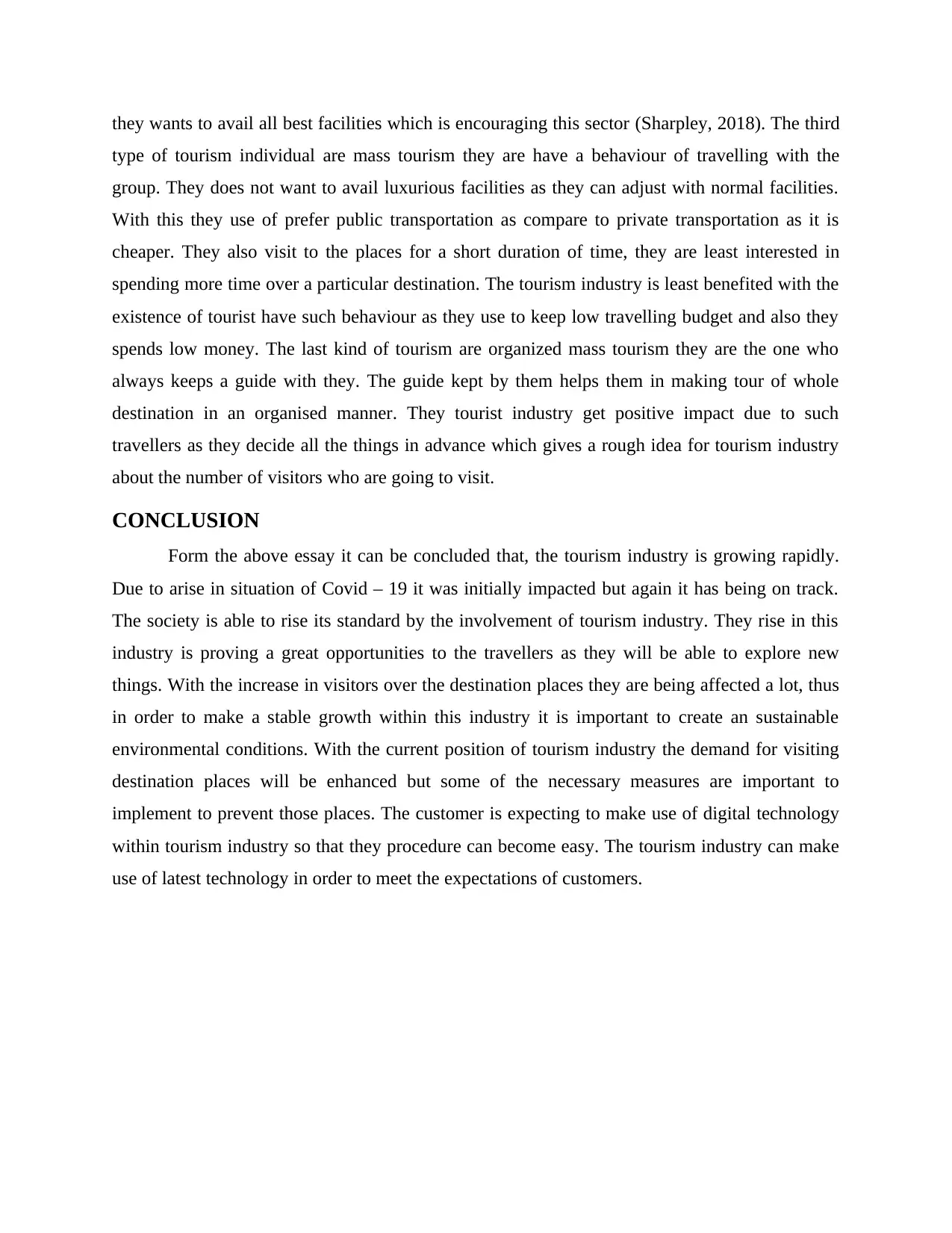
they wants to avail all best facilities which is encouraging this sector (Sharpley, 2018). The third
type of tourism individual are mass tourism they are have a behaviour of travelling with the
group. They does not want to avail luxurious facilities as they can adjust with normal facilities.
With this they use of prefer public transportation as compare to private transportation as it is
cheaper. They also visit to the places for a short duration of time, they are least interested in
spending more time over a particular destination. The tourism industry is least benefited with the
existence of tourist have such behaviour as they use to keep low travelling budget and also they
spends low money. The last kind of tourism are organized mass tourism they are the one who
always keeps a guide with they. The guide kept by them helps them in making tour of whole
destination in an organised manner. They tourist industry get positive impact due to such
travellers as they decide all the things in advance which gives a rough idea for tourism industry
about the number of visitors who are going to visit.
CONCLUSION
Form the above essay it can be concluded that, the tourism industry is growing rapidly.
Due to arise in situation of Covid – 19 it was initially impacted but again it has being on track.
The society is able to rise its standard by the involvement of tourism industry. They rise in this
industry is proving a great opportunities to the travellers as they will be able to explore new
things. With the increase in visitors over the destination places they are being affected a lot, thus
in order to make a stable growth within this industry it is important to create an sustainable
environmental conditions. With the current position of tourism industry the demand for visiting
destination places will be enhanced but some of the necessary measures are important to
implement to prevent those places. The customer is expecting to make use of digital technology
within tourism industry so that they procedure can become easy. The tourism industry can make
use of latest technology in order to meet the expectations of customers.
type of tourism individual are mass tourism they are have a behaviour of travelling with the
group. They does not want to avail luxurious facilities as they can adjust with normal facilities.
With this they use of prefer public transportation as compare to private transportation as it is
cheaper. They also visit to the places for a short duration of time, they are least interested in
spending more time over a particular destination. The tourism industry is least benefited with the
existence of tourist have such behaviour as they use to keep low travelling budget and also they
spends low money. The last kind of tourism are organized mass tourism they are the one who
always keeps a guide with they. The guide kept by them helps them in making tour of whole
destination in an organised manner. They tourist industry get positive impact due to such
travellers as they decide all the things in advance which gives a rough idea for tourism industry
about the number of visitors who are going to visit.
CONCLUSION
Form the above essay it can be concluded that, the tourism industry is growing rapidly.
Due to arise in situation of Covid – 19 it was initially impacted but again it has being on track.
The society is able to rise its standard by the involvement of tourism industry. They rise in this
industry is proving a great opportunities to the travellers as they will be able to explore new
things. With the increase in visitors over the destination places they are being affected a lot, thus
in order to make a stable growth within this industry it is important to create an sustainable
environmental conditions. With the current position of tourism industry the demand for visiting
destination places will be enhanced but some of the necessary measures are important to
implement to prevent those places. The customer is expecting to make use of digital technology
within tourism industry so that they procedure can become easy. The tourism industry can make
use of latest technology in order to meet the expectations of customers.
Paraphrase This Document
Need a fresh take? Get an instant paraphrase of this document with our AI Paraphraser
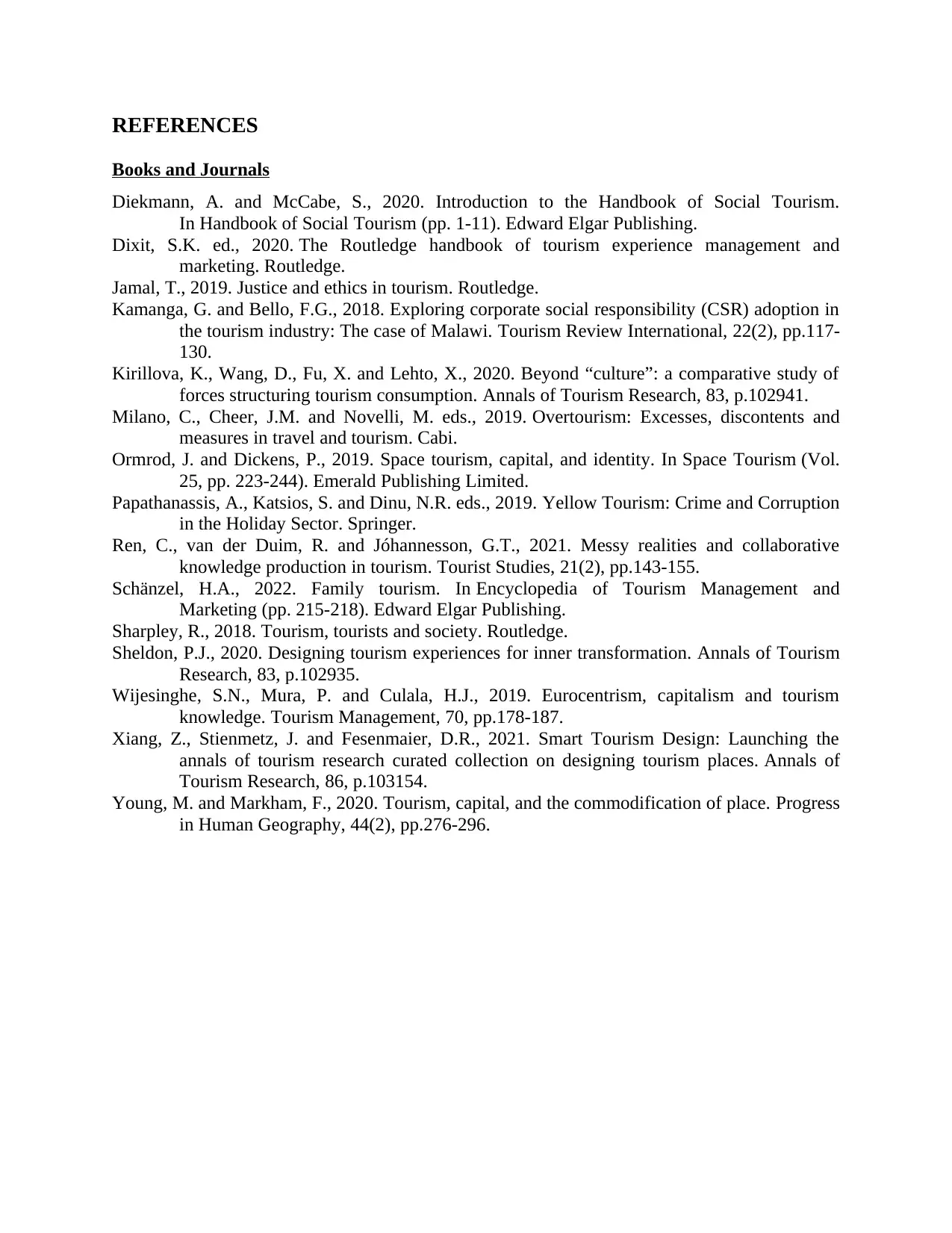
REFERENCES
Books and Journals
Diekmann, A. and McCabe, S., 2020. Introduction to the Handbook of Social Tourism.
In Handbook of Social Tourism (pp. 1-11). Edward Elgar Publishing.
Dixit, S.K. ed., 2020. The Routledge handbook of tourism experience management and
marketing. Routledge.
Jamal, T., 2019. Justice and ethics in tourism. Routledge.
Kamanga, G. and Bello, F.G., 2018. Exploring corporate social responsibility (CSR) adoption in
the tourism industry: The case of Malawi. Tourism Review International, 22(2), pp.117-
130.
Kirillova, K., Wang, D., Fu, X. and Lehto, X., 2020. Beyond “culture”: a comparative study of
forces structuring tourism consumption. Annals of Tourism Research, 83, p.102941.
Milano, C., Cheer, J.M. and Novelli, M. eds., 2019. Overtourism: Excesses, discontents and
measures in travel and tourism. Cabi.
Ormrod, J. and Dickens, P., 2019. Space tourism, capital, and identity. In Space Tourism (Vol.
25, pp. 223-244). Emerald Publishing Limited.
Papathanassis, A., Katsios, S. and Dinu, N.R. eds., 2019. Yellow Tourism: Crime and Corruption
in the Holiday Sector. Springer.
Ren, C., van der Duim, R. and Jóhannesson, G.T., 2021. Messy realities and collaborative
knowledge production in tourism. Tourist Studies, 21(2), pp.143-155.
Schänzel, H.A., 2022. Family tourism. In Encyclopedia of Tourism Management and
Marketing (pp. 215-218). Edward Elgar Publishing.
Sharpley, R., 2018. Tourism, tourists and society. Routledge.
Sheldon, P.J., 2020. Designing tourism experiences for inner transformation. Annals of Tourism
Research, 83, p.102935.
Wijesinghe, S.N., Mura, P. and Culala, H.J., 2019. Eurocentrism, capitalism and tourism
knowledge. Tourism Management, 70, pp.178-187.
Xiang, Z., Stienmetz, J. and Fesenmaier, D.R., 2021. Smart Tourism Design: Launching the
annals of tourism research curated collection on designing tourism places. Annals of
Tourism Research, 86, p.103154.
Young, M. and Markham, F., 2020. Tourism, capital, and the commodification of place. Progress
in Human Geography, 44(2), pp.276-296.
Books and Journals
Diekmann, A. and McCabe, S., 2020. Introduction to the Handbook of Social Tourism.
In Handbook of Social Tourism (pp. 1-11). Edward Elgar Publishing.
Dixit, S.K. ed., 2020. The Routledge handbook of tourism experience management and
marketing. Routledge.
Jamal, T., 2019. Justice and ethics in tourism. Routledge.
Kamanga, G. and Bello, F.G., 2018. Exploring corporate social responsibility (CSR) adoption in
the tourism industry: The case of Malawi. Tourism Review International, 22(2), pp.117-
130.
Kirillova, K., Wang, D., Fu, X. and Lehto, X., 2020. Beyond “culture”: a comparative study of
forces structuring tourism consumption. Annals of Tourism Research, 83, p.102941.
Milano, C., Cheer, J.M. and Novelli, M. eds., 2019. Overtourism: Excesses, discontents and
measures in travel and tourism. Cabi.
Ormrod, J. and Dickens, P., 2019. Space tourism, capital, and identity. In Space Tourism (Vol.
25, pp. 223-244). Emerald Publishing Limited.
Papathanassis, A., Katsios, S. and Dinu, N.R. eds., 2019. Yellow Tourism: Crime and Corruption
in the Holiday Sector. Springer.
Ren, C., van der Duim, R. and Jóhannesson, G.T., 2021. Messy realities and collaborative
knowledge production in tourism. Tourist Studies, 21(2), pp.143-155.
Schänzel, H.A., 2022. Family tourism. In Encyclopedia of Tourism Management and
Marketing (pp. 215-218). Edward Elgar Publishing.
Sharpley, R., 2018. Tourism, tourists and society. Routledge.
Sheldon, P.J., 2020. Designing tourism experiences for inner transformation. Annals of Tourism
Research, 83, p.102935.
Wijesinghe, S.N., Mura, P. and Culala, H.J., 2019. Eurocentrism, capitalism and tourism
knowledge. Tourism Management, 70, pp.178-187.
Xiang, Z., Stienmetz, J. and Fesenmaier, D.R., 2021. Smart Tourism Design: Launching the
annals of tourism research curated collection on designing tourism places. Annals of
Tourism Research, 86, p.103154.
Young, M. and Markham, F., 2020. Tourism, capital, and the commodification of place. Progress
in Human Geography, 44(2), pp.276-296.
1 out of 8
Related Documents
Your All-in-One AI-Powered Toolkit for Academic Success.
+13062052269
info@desklib.com
Available 24*7 on WhatsApp / Email
![[object Object]](/_next/static/media/star-bottom.7253800d.svg)
Unlock your academic potential
Copyright © 2020–2026 A2Z Services. All Rights Reserved. Developed and managed by ZUCOL.




